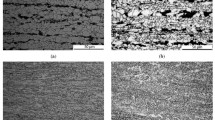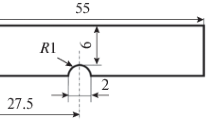Conclusions
-
1.
Changing the carbon content within broad limits has practically no effect on the resistance to fracture of medium-alloy structural steel with the same strength (σb) after quenching and tempering.
-
2.
The essential factor is the method of obtaining the strength level. At the same strength, the steel with a structure of low-temper martensite has higher resistance to fracture than the steel with high-temper martensite.
Similar content being viewed by others
Literature cited
A. P. Gulyaev, D. V. Lebedev, B. M. Ovsyannikov, and L. T. Timoshchuk, “Determining the mechanical characteristics of high-strength steels in tension,” Zavod. Lab., No. 8, 967–969 (1971).
V. G. Laz'ko, V. E. Laz'ko, and B. M. Ovsyannikov, “Effect of carbon on the strength and toughness of structural steel and weld seams,” Probl. Prochn., No. 5, 97–102 (1974).
V. G. Laz'ko, V. E. Laz'ko, and B. M. Ovsyannikov, “Relationship between the strength level and toughness of medium-alloy structural steels,” Probl. Prochn., No. 7, 113–117 (1976).
D. S. Clark and W. R. Varney, Physical Metallurgy for Engineers, D. Van Nostrand, Princeton, New Jersey (1962), pp. 195–197.
A. P. Gulyaev and R. M. Guseinkuliev, “Effect of alloying elements on the properties of Cr-Mn structural steel,” Metalloved. Term. Obrab. Met., No. 4, 27–33 (1967).
A. P. Gulyaev and N. P. Neverova-Skobeleva, “Effect of carbon on the ductile-brittle transition range,” Metalloved. Term. Obrab. Met., No. 4, 17–21 (1957).
J. D. Luban and H. P. Chu, “Optimal carbon content of tempered martensitic steels,” Theor. Inzh. Raschetov, No. 1, 20–25 (1968).
Ya. D. Vishnyakov, Modern Methods of Investigating the Structure of Deformed Crystals [in Russian], Metallurgiya, Moscow (1975).
J. R. Low, “Review of microstructural characteristics of brittle fracture,“ in: Atomic Mechanism of Failure [Russian translation], Metallurgizdat, Moscow (1963), pp. 170–189.
K. Firth and R. Harwood, “Fractography and fracture toughness of high-strength 5% Cr-Mo-V steel,“ in: Fracture Toughness of High-Strength Materials [Russian translation], Metallurgiya, Moscow (1973), pp. 136–152.
I. G. Nekrasova, V. A. Vinokurov, and V. E. Laz'ko, “Resistance to fracture of welded joints of medium-alloy steels,” Probl. Prochn., No. 4, 115–117 (1975).
Author information
Authors and Affiliations
Additional information
Translated from Problemy Prochnosti, No. 5, pp. 64–68, May, 1979.
Rights and permissions
About this article
Cite this article
Laz'ko, V.G., Laz'ko, V.E., Ovsyannikov, B.M. et al. Effect of carbon on resistance to fracture of structural steel. Strength Mater 11, 520–525 (1979). https://doi.org/10.1007/BF00767582
Received:
Issue Date:
DOI: https://doi.org/10.1007/BF00767582




